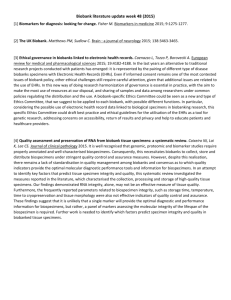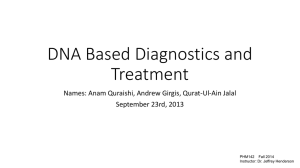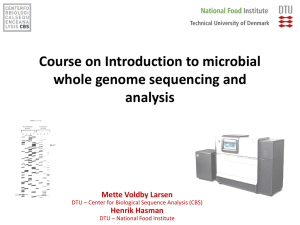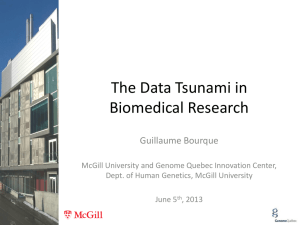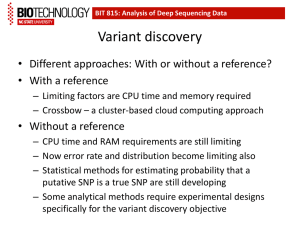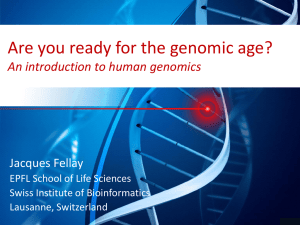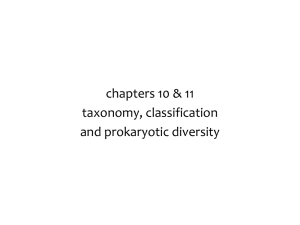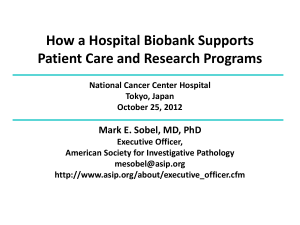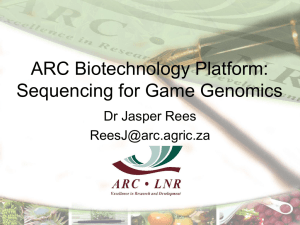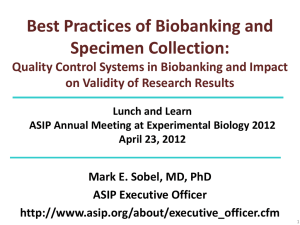Best Practices for Biobanking in the Era of Precision
advertisement
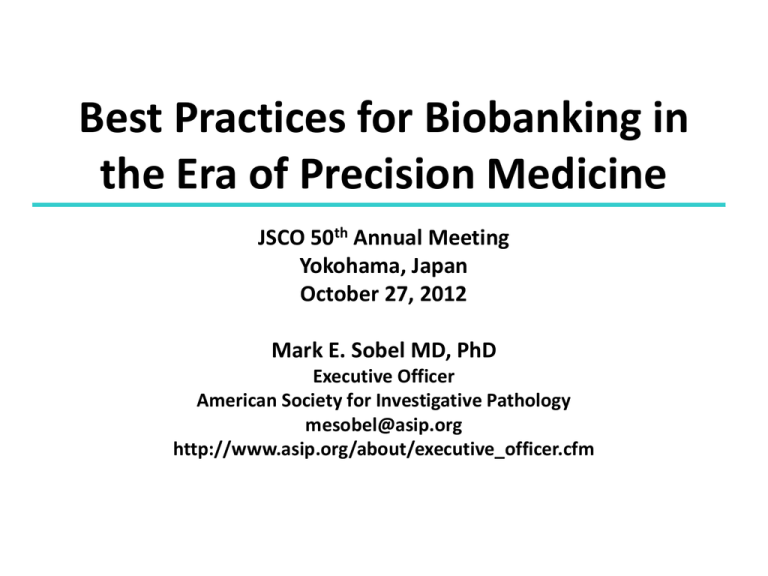
Best Practices for Biobanking in the Era of Precision Medicine JSCO 50th Annual Meeting Yokohama, Japan October 27, 2012 Mark E. Sobel MD, PhD Executive Officer American Society for Investigative Pathology mesobel@asip.org http://www.asip.org/about/executive_officer.cfm The Era of Molecular Medicine A transformation of the practice of medicine AND the public’s fears and expectations •Molecular techniques •Human Genome Project •Information technology Every Era Has Transformative Events Giovanni Battista Morgagni (1682—1771) Images from: Encyclopaedia Britannica, adapted from Dr. Bruce McManus, University of British Columbia 3 Clinical Diagnostic Genome Sequencing The introduction of high-throughput, next-generation sequencing (NGS) in 2005 heralded a critical and transformative step in the history of DNA sequencing. http://en.wikipedia.org/wiki/File: TOSopeninglogo.png http://www.hd-report.com/2009/02/21/startrek-the-original-series-coming-to-blu-ray/ Acknowledgement: Dr. Daniel Farkas, Sequenom Center for Molecular Medicine NEXT-GENERATION SEQUENCING FROM THE POINT OF VIEW OF STAR TREK’S DOCTOR McCOY (“BONES”) Dr. McCoy scanned the patient while Captain Kirk waited impatiently for a diagnosis. “Damn it, Jim. I’m a simple country doctor– this is gonna take a few seconds,” McCoy shouted. “Doctor, I need to now if this Aleuvian Ambassador is going to live or not,” Kirk demanded. “OK, OK, it’s coming together. My tricorder’s on board DNA sequence scanner is detecting foreign DNA sequences in this patient’s genome. Jim, this man has Vulcan Encephalopathy Viral Fever. It’s fatal in Aleuvians.” “Dammit Bones. This man has to live or these negotiations will break down.” NEXT-GENERATION SEQUENCING FROM THE POINT OF VIEW OF STAR TREK’S DOCTOR McCOY (“BONES”) “Hold on. I’m running the sequence through the Medical Database. It’ll compare the viral sequences with the proviral therapeutics in the Pharmacy. Scotty’s still runing that damned Engineering diagnostic so it’s going to take a few minutes. Great ship, Jim, but I’ve been after you for months now to upgrade my computers to keep up with all this data. I may as well be working with catgut and floppy disc drives.” “OK, it’s coming through now. There’s one drug that can help him but I don’t dare give it to him. I don’t dare, Jim!- without getting his consent. There are some strange sequences in his DNA. I just don’t know the significance of this adenine track and can’t predict the outcome--- this nucleotide therapy will cure him or kill him. This patient is going to have to decide.” “Dammit Bones, you’re risking interstellar war here.” “Captain, I am a doctor and I’ve taken an oath to do no harm. I will not proceed without talking to this patient or at least doing some more genomic investigation.” Definitions •Human genome- the “whole genome” of a human consists of 3 gigabytes of information •3 billion base pairs of DNA •46 chromosomes (diploid genome) •Approximately 98% is “intergenic” •“between genes” •Junk DNA? •Does not encode proteins •Human exome •2% of the genome •22,000 pairs of genes •On average, there are 8 exons (protein-encoding segments) per gene = 176,000 exons •Human transcriptome (DNA> RNA> protein) •The expressed RNA transcripts of genes •What a cell is doing at a particular point in time Definitions •Genotype – what the cell is capable of doing •Genome analysis •Phenotype- what the cell is doing •Proteomic analysis (proteins) •Germline or somatic? •Germline•Inheritability •Implications for immediate and extended family •Implications for ethnic group •“Normal” tissues •Somatic•Acquired mutations •Use of “diseased” tissues •No heritable implications for family Clinical Diagnostic Genome Sequencing WGS: Whole genome sequencing WGA: Whole genome analysis Biospecimens are required! Repository or Biobank? •A repository is an organized collection of samples •A biobank is a repository of biological samples Biospecimens in a Human Biobank •Tissue samples •Biopsy •Resection of tissue (surgery) •Dissection of tissue (autopsy) •Blood, sputum, urine, bone marrow •Associated data •Clinical history •Environmental history •Family history •Demographics (gender, age) •How the sample was collected Biospecimens in a Human Biobank •Freshly obtained •Frozen •Fixed •Formalin-fixed paraffin-embedded (FFPE) •Alcohol-fixed •Other fixatives Types of Biobanks •Freezer banks or Cold storage rooms •Glass slide collections •Tissue blocks (FFPE) •Liquid specimens (blood, urine…) •Buccal (cheek) swabs •Extracted analytes (DNA, RNA, protein, etc) Who is Involved? •Donor •Patient •Family •Ethnic group •Physician •Nurse •Administrative assistants •Laboratory technicians •Ethical oversight Requirements of Biobanks •Record keeping •Associated data •Informed consent •What permissions or restrictions are associated with the use of the specimen? •Temperature •Humidity •Light/dark •Controlled access – only authorized individuals can retrieve specimens Confidentiality and Privacy •Confidentiality- the principle in medical ethics that the information a patient reveals to a health care provider is private and has limits on how and when it can be disclosed to a third party •Privacy - culturally specific concept defining the extent, timing, and circumstances of sharing oneself •Physical •Behavioral •Medical Identification of Specimens • Anonymous- the sample was collected without the identity of the donor • Anonymized – the sample was collected with the known identity, but the identification was removed • Coded (Linked) – the sample is given a unique identifier that cannot be easily deciphered • Identified – the sample has a common identifier (name, hospital number) Personalized (Precision) Molecular Medicine • Public’s expectations – Improved health care – Personalized medicine • Public’s fears – Loss of privacy – Loss of employment – Loss of insurance – Social stigmatization Biomedical Research and Biobanks: Translational Research involves interactions between the laboratory bench and patient’s bed •Increase knowledge •Understand biological processes •Improve public health •New diagnostic tests •New prognostic tests •New or improved therapy Biobanks and Clinical Research Health Policy Research Health Outcomes Research Population and Translational Public Health Research Research Involving Patients Reduce Costs Improve Health Clinical Trials Clinical Trials Clinical Trials of Clinical Trials of of Drugs of Devices Diagnostics Models of Care 21 The Translational Research Cycle The Biobank is Essential to Provide Solutions Biobank Tissues, Cells, Fluids, & Products and Dry Data Tools Genetics, Genomics, Proteomics, Imaging, Physiology, Biophysics, Biochemistry, Nanotechnology, Informatics, Sociology, Epidemiology, Statistics Investigative Models Patients as Partners Models of Human Disease Research Questions Translational Research Cycle Pathophysiological and Sociobiological Processes Identification of Novel Markers and Targets Technology Transfer Biomarker or Target Validation Multi-population Assessment, Highthroughput Screening Clinical Trials Adapted from Dr. Bruce McManus, UBC The Path to Clinical Implementation from Translational Research •Analytical validity - Technical feasibility and optimization – does the test measure what we say? •Clinical validity – Diagnostic accuracy - does the test measure a value associated with a clinical condition? •Sensitivity (false negatives) •Specificity (false positives) •Clinical utility •will the test improve making a healthcare decision? •Will the test be cost effective? Clinical Diagnostic Genome Sequencing The introduction of high-throughput, next-generation sequencing (NGS) in 2005 heralded a critical and transformative step in the history of DNA sequencing. This report of the Whole Genome Analysis group of the Association for Molecular Pathology illuminates the opportunities and challenges associated with clinical diagnostic genome sequencing. With the reality of clinical application of next-generation sequencing, technical aspects of molecular testing can be accomplished at greater speed and with higher volume, while much information is obtained. Although this testing is a next logical step for molecular pathology laboratories, the potential impact on the diagnostic process and clinical correlations is extraordinary and clinical interpretation will be challenging. We review the rapidly evolving technologies; provide application examples; discuss aspects of clinical utility, ethics, and consent; and address the analytic, postanalytic, and professional implications. (J Mol Diagn 2012, 14:525540; http://dx.doi.org/10.1016/j.jmoldx.2012.04.006) Coming to a clinic near you… The Potential of Tissue Based Analysis 27 NGS Platforms Although the NGS platforms differ in design and specific chemistries, they are fundamentally related by a paradigm in which sequencing of spatially separated, clonally amplified DNA templates or single DNA molecules is performed in a massively parallel manner. NGS Technology All NGS technologies offer the ability to simultaneously sequence thousands to millions of relatively short nucleic acid sequences in parallel. They can provide orders of magnitude more information, at competitive costs, when large regions of the genome are sequenced. Advantages of NGS Technology Individual sequencing assays based on capillary electrophoresis tend to be: •Expensive •Laborious •Less comprehensive, necessitating serial geneby-gene testing to identify causative mutation(s) Informed Consent and Ethical Considerations The capacity to perform large-scale sequencing on the human genome presents unique challenges regarding the provision of informed consent, particularly in deciding on the level of detail that needs to be shared. No specific guidance exists, and each institution offering such testing is deriving its own policies. With genome testing by NGS, the perceived and real potential risks are magnified compared with genetic tests that target only one gene at a time. Bioinformatics Requirements Major computations performed with NGS data: •Data assembly with base calling at the level of individual reads •Alignment of the assembled sequence to a reference sequence •Variant calling Variant Calling •Different computational analyses devoted to SNPs, small indels, structural variants or large indels, copy number variants •Generation of an unprecedented amount of medical data that result in special informatics needs and require tools for data management, storage, analysis, and archiving •Manage the large data set without error and to ensure proper quality and documentation. Electronic Health Record Reporting of NGS test results raises several issues: •Ordering of the test •Receiving a document that summarizes the clinical interpretation •Storage of the interpretation Incidental Findings An incidental finding is a finding concerning an individual in the course of conducting research that has potential health or reproductive importance and is discovered in the course of conducting research, but is beyond the aims of the study and is not anticipated in the research protocol. Susan M. Wolf, et al. (2012). Genetics in Medicine, 12: 361-384. What about incidental findings that occur in the course of clinical testing? Especially WGS! Presidential Commission for the Study of Bioethical Issues Washington, DC October 2012 http://www.bioethics.gov Challenges Facing Biobanks: Shortage of Quality Biospecimens Lack of standard and uniform operating procedures for: •Collection •Processing •Annotation •Storage •Transport International Society for Biological and Environmental Repositories Communication among Repositories across the Globe www.isber.org A Division of American Society for Investigative Pathology Biospecimen Science What is biospecimen science? Biospecimen Science is the multidisciplinary field of study responsible for establishing tested and proven biospecimen resource-related procedures based on experimentation in the areas of specimen collection, processing, shipping, and storage Why is it needed? Biospecimens are composed of active and reactive living cells or cell products, making them highly complex. The collection, handling, and storage process can profoundly alter the molecular profile and quality of biospecimens. Such alterations, though artificial, can be misinterpreted as disease related or disease specific. High degrees of sensitivity and specificity in new molecular techniques raise the bar for analyte (specimen) data and quality. 39 Biospecimen Science Quality of human biospecimens is multifactorial and is determined by: • • • • • • • Type of specimen: Normal tissue, tumor tissue, serum, plasma Physical state of the specimen Amount and type of specimen characterization data Amount and type of quality control exercised Amount and type of clinical data Permitted use of the specimen The analysis to be performed and the biomolecules targeted by the analysis • The goal of the research (application of the data) 40 International Society for Biological and Environmental Repositories Best Practices for Repositories: Collection, Storage, Retrieval and Distribution of Biological Materials for Research Second Edition: Cell Preservation Technology, Volume 6, Number 1, 2008 Third Edition: Biopreservation and Biobanking Volume 10, Number 2, 2012 41 Quality Control - definition « the operational techniques and activities that are used to satisfy quality requirements », ISO9000:2000 Nestler W. Effect of Quality Control programs on the organizational structure of the hospitals. Bull. NY Acad. Med. 1976;52:157-163 Glenn GC, Hathaway TK. Effects of specimen evaporation on quality control. Am. J. Clin. Pathol. 1976;66:645-652 Calam RR. Reviewing the importance of specimen collection. J. Am. Med. Tech. 1977;39:297-302 « confirmation through provision of objective evidence that requirements for a specific intended use or application are fulfilled », ISO9000:2000 42 Integrated Quality Control Systems QC / Validation Biobank Sample Processing Method Biobank or Research Lab Quality Control Assay Method Validation / Proficiency Testing 43 in vivo Preanalytical Variables - Position - Fasting - Caffeine : - phosphodiesterase cAMP degradation - Smoking - adrenalin secretion - Stress - triglycleride lipase lipid acids linked to albumin - Circadian rhythms # of albumin-available sites - Menstrual cycle - Pregnancy - Physical excercise 44 in vitro Preanalytical Variables • Collection tubes • shedding of components from the tube • silicones, polymeric surfactants, clot inhibitors or activators, rubber stoppers and plastics • adsorption of serum proteins, RNA, DNA to the tube • Anticoagulants • citrate (dilution) • heparin (binding) • EDTA (platelet clumping) • Clotting time and time of incubation before centrifugation • Storage conditions • RT, changes after 8h (m/z<3000) • 4°C, changes after 48h • freeze-thaw cycles, controversy (peptide aggregation, precipitation and adsorption) 45 SPREC-01 Biospecimen preanalytical code Standard Preanalytical Coding for Biospecimens Cancer Epidemiology Biomarkers and Prevention 2010;19:1004-11 46 Ideal QC Biomarkers Ubiquitous Measurable by widely accessible methods On/Off response Stability : capability of a sample material to retain the initial value of a measured quantity for a defined period of time within specific limits when stored under defined conditions ISBER BS WG, Cancer Epidemiol Biomarkers Prevention 2009;18:1017-25 47 Why validate QC methods ? • give full confidence in sample quality • use samples after a long time • provide « reference materials » • ensure validity of research results 48 How Can We Improve? • • Proficiency Testing Accreditation 49 ISBER Proficiency Testing Program: Interlaboratory comparisons to identify problems in laboratories and interlaboratory differences Launched in 2011 •DNA Quantification •RNA Integrity and Quantification Added in 2012 •Cell Viability •Tissue Histology •Tissue Antigenicity 50 CAP Innovates Accreditation for Biorepositories cap.org Summary The Era of Precision Medicine Transformative events - NGS Translational research needs quality biospecimens Biospecimen Science and Best Practices Proficiency Testing and Biobank Accreditation
